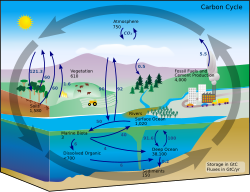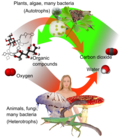Carbon
Carbon is a very important chemical element, with a chemical symbol of C. All known life on Earth needs it to survive. Carbon has atomic mass 12 and atomic number 6. It is a nonmetal, meaning that it is not a metal.
 Graphite (left) and diamond (right), two allotropes of carbon | ||||||||||||||||||||||||||
| General properties | ||||||||||||||||||||||||||
|---|---|---|---|---|---|---|---|---|---|---|---|---|---|---|---|---|---|---|---|---|---|---|---|---|---|---|
| Allotropes | graphite, diamond | |||||||||||||||||||||||||
| Appearance | graphite: black diamond: clear | |||||||||||||||||||||||||
| Standard atomic weight (Ar, standard) | [12.0096, 12.0116][1] | |||||||||||||||||||||||||
| Carbon in the periodic table | ||||||||||||||||||||||||||
| ||||||||||||||||||||||||||
| Atomic number (Z) | 6 | |||||||||||||||||||||||||
| Group | group 14 (carbon group) | |||||||||||||||||||||||||
| Period | period 2 | |||||||||||||||||||||||||
| Block | p-block | |||||||||||||||||||||||||
| Element category | reactive nonmetal, sometimes considered a metalloid | |||||||||||||||||||||||||
| Electron configuration | [He] 2s2 2p2 | |||||||||||||||||||||||||
Electrons per shell | 2, 4 | |||||||||||||||||||||||||
| Physical properties | ||||||||||||||||||||||||||
| Phase at STP | C: Solid | |||||||||||||||||||||||||
| Sublimation point | 3915 K (3642 °C, 6588 °F) | |||||||||||||||||||||||||
| Density (near r.t.) | amorphous: 1.8–2.1 g/cm3[2] graphite: 2.267 g/cm3 diamond: 3.515 g/cm3 | |||||||||||||||||||||||||
| Triple point | 4600 K, 10,800 kPa[3][4] | |||||||||||||||||||||||||
| Heat of fusion | graphite: 117 kJ/mol | |||||||||||||||||||||||||
| Molar heat capacity | graphite: 8.517 J/(mol·K) diamond: 6.155 J/(mol·K) | |||||||||||||||||||||||||
| Atomic properties | ||||||||||||||||||||||||||
| Oxidation states | −4, −3, −2, −1, 0, +1,[5] +2, +3,[6] +4[7] (a mildly acidic oxide) | |||||||||||||||||||||||||
| Electronegativity | Pauling scale: 2.55 | |||||||||||||||||||||||||
| Ionization energies |
| |||||||||||||||||||||||||
| Covalent radius | sp3: 77 pm sp2: 73 pm sp: 69 pm | |||||||||||||||||||||||||
| Van der Waals radius | 170 pm | |||||||||||||||||||||||||
| Spectral lines of carbon | ||||||||||||||||||||||||||
| Other properties | ||||||||||||||||||||||||||
| Natural occurrence | C: Primordial | |||||||||||||||||||||||||
| Crystal structure | graphite: simple hexagonal (black) | |||||||||||||||||||||||||
| Crystal structure | diamond: face-centered diamond-cubic (clear) | |||||||||||||||||||||||||
| Speed of sound thin rod | diamond: 18,350 m/s (at 20 °C) | |||||||||||||||||||||||||
| Thermal expansion | diamond: 0.8 µm/(m·K) (at 25 °C)[8] | |||||||||||||||||||||||||
| Thermal conductivity | graphite: 119–165 W/(m·K) diamond: 900–2300 W/(m·K) | |||||||||||||||||||||||||
| Electrical resistivity | graphite: 7.837 µΩ·m[9] | |||||||||||||||||||||||||
| Magnetic ordering | diamagnetic[10] | |||||||||||||||||||||||||
| Magnetic susceptibility | −5.9·10−6 (graph.) cm3/mol[11] | |||||||||||||||||||||||||
| Young's modulus | diamond: 1050 GPa[8] | |||||||||||||||||||||||||
| Shear modulus | diamond: 478 GPa[8] | |||||||||||||||||||||||||
| Bulk modulus | diamond: 442 GPa[8] | |||||||||||||||||||||||||
| Poisson ratio | diamond: 0.1[8] | |||||||||||||||||||||||||
| Mohs hardness | graphite: 1–2 diamond: 10 | |||||||||||||||||||||||||
| CAS Number | 7440-44-0 | |||||||||||||||||||||||||
| History | ||||||||||||||||||||||||||
| Discovery | Egyptians and Sumerians[12] (3750 BCE) | |||||||||||||||||||||||||
| Recognized as an element by | Antoine Lavoisier[13] (1789) | |||||||||||||||||||||||||
| Main isotopes of carbon | ||||||||||||||||||||||||||
| ||||||||||||||||||||||||||
When iron is alloyed with carbon, hard steel is formed. Carbon in the form of coal is an important fuel.
Chemistry of carbon
A whole type of chemistry, called organic chemistry, is about carbon and its compounds. Carbon makes many types of compounds. Hydrocarbons are molecules with carbon and hydrogen. Methane, Propane, and many other fuels are hydrocarbons. Many of the substances that people use daily are organic compounds.
Carbon, hydrogen, nitrogen, oxygen, and some other elements like sulfur and phosphorus together form most life on earth (see List of biologically important elements). Carbon forms a very large number of organic compounds because it can form strong bonds with itself and with other elements. Because of the amounts of carbon living things have, all organic things are considered "carbon-based".
Each carbon atom usually forms four chemical bonds, which are strong connections to other atoms to form molecules. The kind of bond that carbon makes is called a covalent bond. These bonds allow carbon to form many kinds of small and large molecules. A molecule of methane is the smallest; it has four hydrogen atoms bonded to carbon. The bonds can be double bonds, meaning that two bonds form between carbon and another atom to make a stronger connection. For example, carbon dioxide has two oxygen atoms, and each one is double bonded to carbon. Carbon can even form three bonds with another atom, called a triple bond. For example, in the gas acetylene carbon forms a triple bond with another carbon atom.
By bonding to other carbon atoms, carbon can form long chain-shaped molecules, called polymers, such as plastics and proteins. Atoms of other elements can be part of the long polymer chains, often nitrogen or oxygen.
Pure carbon forms diamond by bonding to four other carbon atoms in a three dimensional crystal. It forms graphite by bonding to three other carbon atoms to form thin flat layers.
Etymology
The name of carbon comes from Latin carbo, meaning charcoal. In many foreign languages the words for carbon, coal and charcoal are synonyms.
Types of carbon
Carbon in nature is found in three forms called allotropes: diamond, graphite, and fullerenes. Graphite, with clay, is in pencils. It is very soft. The carbon atoms in it make rings, which are on top of each other and slide very easily. Diamonds are the hardest natural mineral. Fullerenes are a "soccer ball" shape of carbon. They are mostly of interest to science. A special, man-made, tube-shaped allotrope of carbon is the carbon nanotube. Carbon nanotubes are very hard, so they might be used in armor. Nanotubes might be useful in nanotechnology.
There are 10 million known carbon compounds.

Radiocarbon dating
A radioactive isotope of carbon, carbon-14, can be used to figure out how old some objects are or when something died. As long as something is on the surface of the earth and taking in carbon, the amount of carbon-14 stays the same. When an object stops taking in carbon, the carbon-14 amount goes down. Because the half-life (how long it takes for half of a radioactive isotope to go away) of carbon-14 is 5730 years,[17] scientists can see how old the object is by how much carbon-14 is left.
Where carbon is
Carbon is in many places in the universe. It was first made in old stars. Carbon is the fourth most common element in the sun.[17] The atmospheres of Venus and Mars are mostly carbon dioxide.[18]
Carbon is important to the human body and other living things, and it is the second most common element in the human body, at 23% of all body weight.[17] It is also a key part of many biological molecules (molecules used in life).
Most of the carbon on Earth is coal. Graphite is in many (typically desert) areas, including Sri Lanka, Madagascar, and Russia. Diamonds are rare and are found largely in Africa. Carbon is also in some meteorites.
Carbon Media
Comet C/2014 Q2 (Lovejoy) surrounded by glowing carbon vapor
Some allotropes of carbon: a) diamond; b) graphite; c) lonsdaleite; d–f) fullerenes (C60, C540, C70); g) amorphous carbon; h) carbon nanotube
"Present day" (1990s) sea surface dissolved inorganic carbon concentration (from the GLODAP climatology)
Diagram of the carbon cycle. The black numbers indicate how much carbon is stored in various reservoirs, in billions tonnes ("GtC" stands for gigatonnes of carbon; figures are c. 2004). The purple numbers indicate how much carbon moves between reservoirs each year. The sediments, as defined in this diagram, do not include the ≈70 million GtC of carbonate rock and kerogen.
Structural formula of methane, the simplest possible organic compound.
Correlation between the carbon cycle and formation of organic compounds. In plants, carbon dioxide formed by carbon fixation can join with water in photosynthesis (green) to form organic compounds, which can be used and further converted by both plants and animals.
Related pages
References
- ↑ Meija, J.; Coplen, T. B.; Berglund, M.; Brand, W.A.; De Bièvre, P.; Gröning, M.; Holden, N.E.; Irrgeher, J.; Loss, R.D.; Walczyk, T.; Prohaska, T. (2016). "Atomic weights of the elements 2013 (IUPAC Technical Report)". Pure and Applied Chemistry. 88 (3): 265–91. doi:10.1515/pac-2015-0305.
{{cite journal}}: Unknown parameter|displayauthors=ignored (|display-authors=suggested) (help) - ↑ Lide, D. R., ed. (2005). CRC Handbook of Chemistry and Physics (86th ed.). Boca Raton (FL): CRC Press. ISBN 0-8493-0486-5.
- ↑ Haaland, D (1976). "Graphite-liquid-vapor triple point pressure and the density of liquid carbon". Carbon. 14 (6): 357. doi:10.1016/0008-6223(76)90010-5.
- ↑ Savvatimskiy, A (2005). "Measurements of the melting point of graphite and the properties of liquid carbon (a review for 1963–2003)". Carbon. 43 (6): 1115. doi:10.1016/j.carbon.2004.12.027.
- ↑ "Fourier Transform Spectroscopy of the Electronic Transition of the Jet-Cooled CCI Free Radical" (PDF). Retrieved 2007-12-06.
- ↑ "Fourier Transform Spectroscopy of the System of CP" (PDF). Retrieved 2007-12-06.
- ↑ "Carbon: Binary compounds". Retrieved 2007-12-06.
- ↑ 8.0 8.1 8.2 8.3 8.4 Properties of diamond, Ioffe Institute Database
- ↑ "Material Properties- Misc Materials". www.nde-ed.org. Retrieved 12 November 2016.
- ↑ Magnetic susceptibility of the elements and inorganic compounds, in Handbook of Chemistry and Physics 81st edition, CRC press.
- ↑ Weast, Robert (1984). CRC, Handbook of Chemistry and Physics. Boca Raton, Florida: Chemical Rubber Company Publishing. pp. E110. ISBN 0-8493-0464-4.
- ↑ "History of Carbon and Carbon Materials - Center for Applied Energy Research - University of Kentucky". Caer.uky.edu. Retrieved 2008-09-12.
- ↑ Senese, Fred (2000-09-09). "Who discovered carbon?". Frostburg State University. Retrieved 2007-11-24.
- ↑ "Fourier Transform Spectroscopy of the System of CP" (PDF). Retrieved 2007-12-06.
- ↑ "Fourier Transform Spectroscopy of the Electronic Transition of the Jet-Cooled CCI Free Radical" (PDF). Retrieved 2007-12-06.
- ↑ "Carbon: Binary compounds". Retrieved 2007-12-06.
- ↑ 17.0 17.1 17.2 Emsley, John (2001). Nature's Building blocks. Oxford University Press. ISBN 0-19-850341-5.
- ↑ University of Sheffield and Webelements Ltd. (2007). "Chemistry : Periodic Table : carbon : key information".












